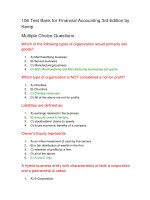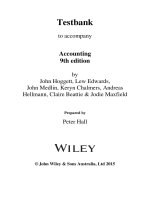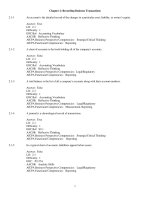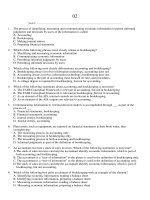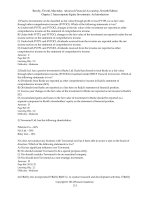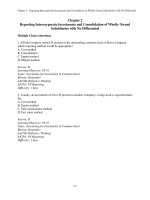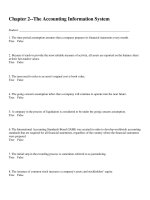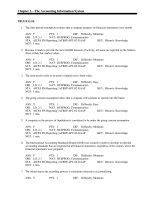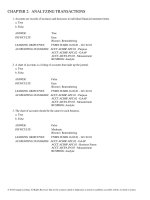Financial accounting 3rd edition kemp test bank
Bạn đang xem bản rút gọn của tài liệu. Xem và tải ngay bản đầy đủ của tài liệu tại đây (208.74 KB, 45 trang )
Financial Accounting, 3e (Kemp/Waybright)
Chapter 2 Analyzing and Recording Business Transactions
2.1 Questions
1) Account titles such as Marketing Expense and Depreciation Expense would be numbered
starting with a 3.
Answer: FALSE
Diff: 1
LO: 2-1
EOC Ref: S2-4
AACSB: Analytical Thinking
AICPA Business: Strategic/Critical Thinking
AICPA Functional: Reporting
2) A listing of all accounts in numerical order is called a chart of accounts.
Answer: TRUE
Diff: 1
LO: 2-1
EOC Ref: S2-4
AACSB: Reflective Thinking (Able to understand oneself in the context of society)
AICPA Business: Strategic/Critical Thinking
AICPA Functional: Decision Modeling
3) An account numbered 321 would be considered a Stockholders' Equity account as it begins
with a 3.
Answer: TRUE
Diff: 1
LO: 2-1
EOC Ref: S2-4
AACSB: Analytical Thinking
AICPA Business: Strategic/Critical Thinking
AICPA Functional: Reporting
4) The Stockholders' Equity section would include accounts such as Retained Earnings and
Revenues.
Answer: TRUE
Diff: 1
LO: 2-1
EOC Ref: S2-2
AACSB: Analytical Thinking
AICPA Business: Strategic/Critical Thinking
AICPA Functional: Reporting
1
Copyright © 2015 Pearson Education, Inc.
5) Items of value that a company owns are called Stockholders' Equity.
Answer: FALSE
Diff: 1
LO: 2-1
EOC Ref: Vocabulary
AACSB: Reflective Thinking (Able to understand oneself in the context of society)
AICPA Business: Strategic/Critical Thinking
AICPA Functional: Decision Modeling
6) A business generally has fewer liability accounts than asset accounts.
Answer: TRUE
Diff: 1
LO: 2-1
EOC Ref: S2-1
AACSB: Reflective Thinking (Able to understand oneself in the context of society)
7) A business generally has just one expense account.
Answer: FALSE
Diff: 1
LO: 2-1
EOC Ref: S2-2
AACSB: Reflective Thinking (Able to understand oneself in the context of society)
8) Obligations that are owed to others due to past transactions are categorized as:
A) Stockholders' Equity.
B) expenses.
C) assets.
D) liabilities.
Answer: D
Diff: 1
LO: 2-1
EOC Ref: Vocabulary
AACSB: Reflective Thinking (Able to understand oneself in the context of society)
AICPA Business: Strategic/Critical Thinking
AICPA Functional: Decision Modeling
2
Copyright © 2015 Pearson Education, Inc.
9) Monies owed to a company on a written promise to pay a fixed amount of money by a certain
date would be called a(n):
A) note payable.
B) note receivable.
C) account payable.
D) account receivable.
Answer: A
Diff: 1
LO: 2-1
EOC Ref: S2-2
AACSB: Reflective Thinking (Able to understand oneself in the context of society)
AICPA Business: Strategic/Critical Thinking
AICPA Functional: Decision Modeling
10) Items such as salaries and interest that have been incurred, but not yet paid, are called:
A) accrued assets.
B) accrued liabilities.
C) accrued revenues.
D) accrued notes.
Answer: B
Diff: 1
LO: 2-1
EOC Ref: S2-2
AACSB: Reflective Thinking (Able to understand oneself in the context of society)
AICPA Business: Strategic/Critical Thinking
AICPA Functional: Decision Modeling
11) The order in which accounts appear in the chart of accounts is:
A) liabilities, assets, revenues, Stockholders' Equity, expenses.
B) Stockholders' Equity, expenses, revenue, liabilities, assets.
C) assets, Stockholders' Equity, revenues, expenses, liabilities.
D) Assets, Liabilities, Stockholders' Equity, revenues, expenses.
Answer: D
Diff: 1
LO: 2-1
EOC Ref: S2-2
AACSB: Analytical Thinking
AICPA Business: Strategic/Critical Thinking
AICPA Functional: Measurement and Reporting
3
Copyright © 2015 Pearson Education, Inc.
12) An account starting with a number 1 would indicate:
A) an asset.
B) Stockholders' Equity.
C) a revenue.
D) a liability.
Answer: A
Diff: 1
LO: 2-1
EOC Ref: S2-2
AACSB: Analytical Thinking
AICPA Business: Strategic/Critical Thinking
AICPA Functional: Measurement and Reporting
13) All payables are listed as:
A) assets.
B) liabilities.
C) Stockholders' Equity.
D) revenue.
Answer: B
Diff: 1
LO: 2-1
EOC Ref: S2-2
AACSB: Reflective Thinking (Able to understand oneself in the context of society)
AICPA Business: Strategic/Critical Thinking
AICPA Functional: Decision Modeling
14) Accounts that start with the numbers 6-9 would probably be:
A) other revenues and expenses.
B) other assets and liabilities.
C) other Stockholders' Equity.
D) other assets and revenues.
Answer: A
Diff: 1
LO: 2-1
EOC Ref: S2-2
AACSB: Analytical Thinking
AICPA Business: Strategic/Critical Thinking
AICPA Functional: Measurement and Reporting
4
Copyright © 2015 Pearson Education, Inc.
15) A type of asset in which a customer owes the company money would be a:
A) dividend.
B) receivable.
C) payable.
D) sale.
Answer: B
Diff: 1
LO: 2-1
EOC Ref: S2-2
AACSB: Reflective Thinking (Able to understand oneself in the context of society)
AICPA Business: Strategic/Critical Thinking
AICPA Functional: Decision Modeling
16) Expenses paid in advance such as rent and insurance are classified as prepaid expenses. Into
what category are they placed?
A) Liabilities
B) Revenues
C) Expenses
D) Assets
Answer: D
Diff: 2
LO: 2-1
EOC Ref: S2-2
AACSB: Reflective Thinking (Able to understand oneself in the context of society)
AICPA Business: Strategic/Critical Thinking
AICPA Functional: Decision Modeling
17) Dividends are paid with cash to shareholders. Dividends are in what category of the chart of
accounts?
A) Revenue
B) Assets
C) Stockholders' Equity
D) Liabilities
Answer: C
Diff: 2
LO: 2-1
EOC Ref: S2-2
AACSB: Reflective Thinking (Able to understand oneself in the context of society)
AICPA Business: Strategic/Critical Thinking
AICPA Functional: Decision Modeling
5
Copyright © 2015 Pearson Education, Inc.
18) Accounts starting with the number 4 would represent:
A) assets.
B) liabilities.
C) revenues.
D) expenses.
Answer: C
Diff: 1
LO: 2-1
EOC Ref: S2-2
AACSB: Analytical Thinking
AICPA Business: Strategic/Critical Thinking
AICPA Functional: Measurement and Reporting
19) Marketing expenditures account 511 would belong to what category of accounts?
A) Assets
B) Expenses
C) Revenues
D) Liabilities
Answer: B
Diff: 1
LO: 2-1
EOC Ref: S2-2
AACSB: Analytical Thinking
AICPA Business: Strategic/Critical Thinking
AICPA Functional: Measurement and Reporting
20) Land, Cash, Office Equipment and Accounts Receivable belong to what category of
accounts?
A) Liabilities
B) Revenues
C) Expenses
D) Assets
Answer: D
Diff: 1
LO: 2-1
EOC Ref: S2-4
AACSB: Reflective Thinking (Able to understand oneself in the context of society)
AICPA Business: Strategic/Critical Thinking
AICPA Functional: Decision Modeling
6
Copyright © 2015 Pearson Education, Inc.
21) Dividends, revenues, and Expenses all:
A) start with the same chart of account number.
B) start with different chart of accounts numbers.
C) appear in the chart of accounts under assets.
D) appear in the chart of accounts under liabilities.
Answer: B
Diff: 1
LO: 2-1
EOC Ref: S2-2
AACSB: Analytical Thinking
AICPA Business: Strategic/Critical Thinking
AICPA Functional: Measurement and Reporting
22) Which of the following would start with a 1 in the chart of accounts?
A) Land and Buildings
B) Depreciation Expense and Marketing Expense
C) Merchandise Sales and Rent Revenue
D) Common Stock and Dividends
Answer: A
Diff: 1
LO: 2-1
EOC Ref: S2-2
AACSB: Analytical Thinking
AICPA Business: Strategic/Critical Thinking
AICPA Functional: Measurement and Reporting
23) Which of the following would start with a 2 in the chart of accounts?
A) Income Taxes Payable and Salaries Payable
B) Common Stock and Dividends
C) Cash and Accounts Receivable
D) Sales and Service Revenue
Answer: A
Diff: 1
LO: 2-1
EOC Ref: S2-2
AACSB: Analytical Thinking
AICPA Business: Strategic/Critical Thinking
AICPA Functional: Measurement and Reporting
7
Copyright © 2015 Pearson Education, Inc.
24) A promissory note owed to another company would most likely appear in which of the
following accounts?
A) Accounts Receivable
B) Accounts Payable
C) Notes Receivable
D) Notes Payable
Answer: D
Diff: 1
LO: 2-1
EOC Ref: S2-11
AACSB: Reflective Thinking (Able to understand oneself in the context of society)
AICPA Business: Strategic/Critical Thinking
AICPA Functional: Measurement and Reporting
25) A chart of accounts does NOT include:
A) Stockholders' Equity.
B) assets.
C) names of customers.
D) liabilities.
Answer: C
Diff: 1
LO: 2-1
EOC Ref: S2-4
AACSB: Reflective Thinking (Able to understand oneself in the context of society)
AICPA Business: Strategic/Critical Thinking
AICPA Functional: Decision Modeling
26) Which of the following is an expense account?
A) Prepaid Insurance
B) Advertising
C) Accounts Payable
D) Cash
Answer: B
Diff: 1
LO: 2-1
EOC Ref: S2-2
AACSB: Reflective Thinking (Able to understand oneself in the context of society)
AICPA Business: Strategic/Critical Thinking
AICPA Functional: Decision Modeling
8
Copyright © 2015 Pearson Education, Inc.
27) Which of the following is NOT a revenue account?
A) Salaries
B) Sales
C) Fees Earned
D) Professional Fees
Answer: A
Diff: 1
LO: 2-1
EOC Ref: S2-2
AACSB: Reflective Thinking (Able to understand oneself in the context of society)
AICPA Business: Strategic/Critical Thinking
AICPA Functional: Decision Modeling
28) The account used to record payment of a telephone bill immediately after receiving it, would
be a(n):
A) asset.
B) liability.
C) revenue.
D) expense.
Answer: D
Diff: 1
LO: 2-1
EOC Ref: S2-2
AACSB: Reflective Thinking (Able to understand oneself in the context of society)
AICPA Business: Strategic/Critical Thinking
AICPA Functional: Decision Modeling
29) Obligations owed by a company to banks, for instance, are called:
A) notes receivable.
B) Notes Payable.
C) Accounts Receivable.
D) Accounts Payable.
Answer: B
Diff: 1
LO: 2-1
EOC Ref: S2-2
AACSB: Reflective Thinking (Able to understand oneself in the context of society)
AICPA Business: Strategic/Critical Thinking
AICPA Functional: Decision Modeling
9
Copyright © 2015 Pearson Education, Inc.
30) Net income and dividends are part of:
A) liabilities.
B) Stockholders' Equity.
C) assets.
D) net income.
Answer: B
Diff: 1
LO: 2-1
EOC Ref: S2-2
AACSB: Reflective Thinking (Able to understand oneself in the context of society)
AICPA Business: Strategic/Critical Thinking
AICPA Functional: Decision Modeling
31) Which is NOT a part of Stockholders' Equity?
A) Revenues
B) Expenses
C) Accounts Receivable
D) Dividends
Answer: C
Diff: 1
LO: 2-1
EOC Ref: S2-2
AACSB: Reflective Thinking (Able to understand oneself in the context of society)
AICPA Business: Strategic/Critical Thinking
AICPA Functional: Decision Modeling
32) Collection of money from a cash customer represents a(n):
A) liability.
B) expense.
C) revenue.
D) stock.
Answer: C
Diff: 1
LO: 2-1
EOC Ref: S2-2
AACSB: Reflective Thinking (Able to understand oneself in the context of society)
AICPA Business: Strategic/Critical Thinking
AICPA Functional: Decision Modeling
10
Copyright © 2015 Pearson Education, Inc.
33) How does an account receivable differ from a note receivable?
A) A note receivable is an asset while an account receivable is not.
B) An account receivable is a written pledge while a note receivable is not.
C) An account receivable is always an amount due from the company's customers while a note
receivable is always an amount due from a bank.
D) Notes receivable are written pledges while Accounts Receivable are not.
Answer: D
Diff: 1
LO: 2-1
EOC Ref: E2-16A
AACSB: Reflective Thinking (Able to understand oneself in the context of society)
AICPA Business: Strategic/Critical Thinking
AICPA Functional: Decision Modeling
34) Which of the following is TRUE regarding the accounts supplies payable and supplies
expense?
A) These account titles both mean the same thing and are used interchangeably.
B) Supplies payable represents the cost of supplies bought on account but not yet paid for, while
supplies expense represents the cost of the supplies which have been paid for.
C) Supplies payable represents the cost of supplies bought on account but not yet paid for, while
supplies expense represents the cost of supplies used to deliver goods or services to customers.
D) Supplies expense represents the cost of supplies bought on account but not yet paid for, while
supplies payable represents the cost of supplies used to deliver goods or services to customers.
Answer: C
Diff: 2
LO: 2-1
EOC Ref: S2-1
AACSB: Reflective Thinking (Able to understand oneself in the context of society)
AICPA Business: Strategic/Critical Thinking
AICPA Functional: Decision Modeling
35) Which of the following is NOT a liability?
A) Accounts Payable
B) Interest Payable
C) Rent Expense
D) All of the above are liabilities.
Answer: C
Diff: 1
LO: 2-1
EOC Ref: S2-4
AACSB: Reflective Thinking (Able to understand oneself in the context of society)
11
Copyright © 2015 Pearson Education, Inc.
36) Which of the following is NOT an asset?
A) Revenues
B) Accounts Receivable
C) Prepaid Rent
D) All of the above are assets.
Answer: A
Diff: 1
LO: 2-1
EOC Ref: S2-4
AACSB: Reflective Thinking (Able to understand oneself in the context of society)
2.2 Questions
1) Double-entry accounting requires that every business transaction impact at least two different
accounts.
Answer: TRUE
Diff: 1
LO: 2-2
EOC Ref: S2-3
AACSB: Analytical Thinking
AICPA Business: Strategic/Critical Thinking
AICPA Functional: Measurement and Reporting
2) A T-account is a way to visualize the increases and decreases to the value of an account.
Answer: TRUE
Diff: 1
LO: 2-2
EOC Ref: S2-6
AACSB: Analytical Thinking
AICPA Business: Strategic/Critical Thinking
AICPA Functional: Measurement and Reporting
3) The debit (left) side of an account always indicates an increase in the value of the account.
Answer: FALSE
Diff: 1
LO: 2-2
EOC Ref: S2-6
AACSB: Analytical Thinking
AICPA Business: Strategic/Critical Thinking
AICPA Functional: Measurement and Reporting
12
Copyright © 2015 Pearson Education, Inc.
4) The credit (right) side of an account shows an increase or decrease depending upon the type of
account.
Answer: TRUE
Diff: 1
LO: 2-2
EOC Ref: S2-6
AACSB: Analytical Thinking
AICPA Business: Strategic/Critical Thinking
AICPA Functional: Measurement and Reporting
5) Accounts that increase on the credit side are Assets, dividends and Expenses (ADE).
Answer: FALSE
Diff: 1
LO: 2-2
EOC Ref: S2-6
AACSB: Analytical Thinking
AICPA Business: Strategic/Critical Thinking
AICPA Functional: Measurement and Reporting
6) Accounts that increase on the credit side are Liabilities, Common Stock, Revenues and
Retained Earnings (LCR).
Answer: TRUE
Diff: 1
LO: 2-2
EOC Ref: S2-6
AACSB: Analytical Thinking
AICPA Business: Strategic/Critical Thinking
AICPA Functional: Measurement and Reporting
7) Normal balance refers to the positive increase of an account and identifies the side of the
account (Debit or Credit) to which this positive balance is recorded.
Answer: TRUE
Diff: 1
LO: 2-2
EOC Ref: S2-6
AACSB: Analytical Thinking
AICPA Business: Strategic/Critical Thinking
AICPA Functional: Measurement and Reporting
13
Copyright © 2015 Pearson Education, Inc.
8) Accounts Payable, Taxes Payable, and Notes Payable:
A) increase on the debit side, decrease on the credit side and are assets.
B) decrease on the debit side, increase on the credit side and are liabilities.
C) increase on the debit side, decrease on the credit side and are expenses.
D) decrease on the debit side, increase on the credit side and are revenues.
Answer: B
Diff: 2
LO: 2-2
EOC Ref: S2-8
AACSB: Analytical Thinking
AICPA Business: Strategic/Critical Thinking
AICPA Functional: Measurement and Reporting
9) The Stockholders' Equity accounts Dividends, Revenues and Expenses have normal balances
of:
A) credit, debit, and debit, respectively.
B) debit, credit, and credit, respectively.
C) debit, credit, and debit, respectively.
D) credit, credit, and credit, respectively.
Answer: C
Diff: 1
LO: 2-2
EOC Ref: S2-8
AACSB: Analytical Thinking
AICPA Business: Strategic/Critical Thinking
AICPA Functional: Measurement and Reporting
10) Cash, Common Stock, and Advertising Expense have normal balances of:
A) credit, credit, and credit, respectively.
B) debit, credit, and debit, respectively.
C) debit, debit, and credit, respectively.
D) credit, debit, and debit, respectively.
Answer: B
Diff: 1
LO: 2-2
EOC Ref: S2-8
AACSB: Analytical Thinking
AICPA Business: Strategic/Critical Thinking
AICPA Functional: Measurement and Reporting
14
Copyright © 2015 Pearson Education, Inc.
11) Dividends, Accounts Receivable, and Buildings have normal balances of:
A) credit, debit, and debit, respectively.
B) debit, debit, and credit, respectively.
C) credit, credit, and credit, respectively.
D) debit, debit, and debit, respectively.
Answer: D
Diff: 1
LO: 2-2
EOC Ref: S2-8
AACSB: Analytical Thinking
AICPA Business: Strategic/Critical Thinking
AICPA Functional: Measurement and Reporting
12) Revenues, Accounts Receivable, and Common Stock have normal balances of:
A) credit, debit, and credit, respectively.
B) debit, debit, and credit, respectively.
C) credit, credit, and credit, respectively.
D) debit, debit, and debit, respectively.
Answer: A
Diff: 1
LO: 2-2
EOC Ref: S2-8
AACSB: Analytical Thinking
AICPA Business: Strategic/Critical Thinking
AICPA Functional: Measurement and Reporting
13) Office Furniture, Wages Payable and Dividends have normal balances of:
A) credit, credit, and credit, respectively.
B) debit, credit, and debit, respectively.
C) debit, debit, and credit, respectively.
D) credit, debit, and debit, respectively.
Answer: B
Diff: 1
LO: 2-2
EOC Ref: S2-8
AACSB: Analytical Thinking
AICPA Business: Strategic/Critical Thinking
AICPA Functional: Measurement and Reporting
15
Copyright © 2015 Pearson Education, Inc.
14) Which of the following is an unofficial tool of accounting?
A) Account
B) T-account
C) Debit
D) Credit
Answer: B
Diff: 1
LO: 2-2
EOC Ref: Vocabulary
AACSB: Reflective Thinking (Able to understand oneself in the context of society)
AICPA Business: Strategic/Critical Thinking
AICPA Functional: Decision Modeling
15) T-accounts aid in separating:
A) increases and decreases in an account.
B) the equality of the credits.
C) the equality of debits and credits in the accounting equation.
D) the balances of all of the accounts.
Answer: A
Diff: 1
LO: 2-2
EOC Ref: S2-7
AACSB: Analytical Thinking
AICPA Business: Strategic/Critical Thinking
AICPA Functional: Measurement and Reporting
16) The total amount of debits must equal the total amount of credits. This is a rule of:
A) T-accounts.
B) the chart of accounts.
C) double-entry accounting.
D) normal balances.
Answer: C
Diff: 1
LO: 2-2
EOC Ref: Vocabulary
AACSB: Reflective Thinking (Able to understand oneself in the context of society)
AICPA Business: Strategic/Critical Thinking
AICPA Functional: Decision Modeling
16
Copyright © 2015 Pearson Education, Inc.
17) A T-account has a $759 credit balance. This account is most likely NOT:
A) Accounts Payable.
B) Sales Revenue.
C) Accounts Receivable.
D) Common Stock.
Answer: C
Diff: 2
LO: 2-2
EOC Ref: S2-6
AACSB: Analytical Thinking
AICPA Business: Strategic/Critical Thinking
AICPA Functional: Measurement and Reporting
18) A T-account has a $509 debit balance. This account is most likely NOT:
A) Common Stock.
B) Land.
C) Advertising Expense.
D) Dividends.
Answer: A
Diff: 2
LO: 2-2
EOC Ref: S2-6
AACSB: Analytical Thinking
AICPA Business: Strategic/Critical Thinking
AICPA Functional: Measurement and Reporting
19) A T-account has a $382 debit balance. This account is most likely:
A) Income Taxes Payable.
B) Common Stock.
C) Cash.
D) Magazine Sales.
Answer: C
Diff: 2
LO: 2-2
EOC Ref: S2-6
AACSB: Analytical Thinking
AICPA Business: Strategic/Critical Thinking
AICPA Functional: Measurement and Reporting
17
Copyright © 2015 Pearson Education, Inc.
20) A T-account has a $299 credit balance. This account is most likely NOT:
A) Accounts Receivable.
B) Bicycle Repair Revenue.
C) Wages Payable.
D) Common Stock.
Answer: A
Diff: 2
LO: 2-2
EOC Ref: S2-6
AACSB: Analytical Thinking
AICPA Business: Strategic/Critical Thinking
AICPA Functional: Measurement and Reporting
21) A T-account has a $922 credit balance. This account is most likely:
A) Office Equipment.
B) Rent Expense.
C) Dividends.
D) Sales Revenue.
Answer: D
Diff: 2
LO: 2-2
EOC Ref: S2-6
AACSB: Analytical Thinking
AICPA Business: Strategic/Critical Thinking
AICPA Functional: Measurement and Reporting
22) A T-account has a $388 credit balance. This account is most likely:
A) an expense.
B) a dividend account.
C) an asset.
D) a stock account.
Answer: D
Diff: 2
LO: 2-2
EOC Ref: S2-6
AACSB: Analytical Thinking
AICPA Business: Strategic/Critical Thinking
AICPA Functional: Measurement and Reporting
18
Copyright © 2015 Pearson Education, Inc.
23) Debit means:
A) decrease.
B) increase.
C) the right side of an account.
D) the left side of an account.
Answer: D
Diff: 1
LO: 2-2
EOC Ref: S2-5
AACSB: Reflective Thinking (Able to understand oneself in the context of society)
AICPA Business: Strategic/Critical Thinking
AICPA Functional: Decision Modeling
24) Credit means:
A) decrease.
B) increase.
C) the right side of an account.
D) the left side of an account.
Answer: C
Diff: 1
LO: 2-2
EOC Ref: S2-5
AACSB: Reflective Thinking (Able to understand oneself in the context of society)
AICPA Business: Strategic/Critical Thinking
AICPA Functional: Decision Modeling
25) An example of accounts with normal debit balances would be:
A) liabilities.
B) expenses.
C) revenues.
D) Stockholders' Equity.
Answer: B
Diff: 1
LO: 2-2
EOC Ref: S2-8
AACSB: Analytical Thinking
AICPA Business: Strategic/Critical Thinking
AICPA Functional: Measurement and Reporting
19
Copyright © 2015 Pearson Education, Inc.
26) An example of accounts with normal credit balances would be:
A) revenues.
B) assets.
C) expenses.
D) dividends.
Answer: A
Diff: 1
LO: 2-2
EOC Ref: S2-8
AACSB: Analytical Thinking
AICPA Business: Strategic/Critical Thinking
AICPA Functional: Measurement and Reporting
27) A T-account has which of the following three major parts?
A) A debit side, a credit side, and a balance
B) A debit side, a credit side, and a total column
C) A title, a current date, and a balance
D) A title, a debit side, and a credit side
Answer: D
Diff: 2
LO: 2-2
EOC Ref: S2-6
AACSB: Analytical Thinking
AICPA Business: Strategic/Critical Thinking
AICPA Functional: Measurement and Reporting
28) The fact that each transaction has a dual effect on the accounting equation provides the basis
for what is called:
A) single-entry accounting.
B) double-entry accounting.
C) compound-entry accounting.
D) multiple-entry accounting.
Answer: B
Diff: 1
LO: 2-2
EOC Ref: S2-3
AACSB: Analytical Thinking
AICPA Business: Strategic/Critical Thinking
AICPA Functional: Measurement and Reporting
20
Copyright © 2015 Pearson Education, Inc.
29) An investment of cash in a business:
A) represents an obligation of the business.
B) decreases Stockholders' Equity.
C) increases cash.
D) appears in a liability account.
Answer: C
Diff: 1
LO: 2-2
EOC Ref: S2-8
AACSB: Analytical Thinking
AICPA Business: Strategic/Critical Thinking
AICPA Functional: Measurement and Reporting
30) The difference between the total debits and total credits of an account is called a:
A) trial balance.
B) sub-total.
C) ruling.
D) balance.
Answer: D
Diff: 2
LO: 2-2
EOC Ref: S2-7
AACSB: Reflective Thinking (Able to understand oneself in the context of society)
AICPA Business: Strategic/Critical Thinking
AICPA Functional: Decision Modeling
31) When the bank takes money out of a company's account, why does the bank say that they
have debited that account?
A) The bank has increased the company's assets and assets increase with debits.
B) The bank has decreased its' liability to the company and liabilities decrease with debits.
C) The bank has decreased the company's assets and assets decrease with debits.
D) The bank has increased its' liability to the company and liabilities increase with debits.
Answer: B
Diff: 2
LO: 2-2
EOC Ref: S2-6
AACSB: Analytical Thinking
AICPA Business: Strategic/Critical Thinking
AICPA Functional: Measurement and Reporting
21
Copyright © 2015 Pearson Education, Inc.
32) A company has a fifty million dollar debit balance in its cash account. Given this
information, which of the following is a TRUE statement?
A) It is not normal for a business to have this much cash, therefore this is NOT a normal account
balance.
B) It is NOT ever normal for the cash account to have a debit balance.
C) Normal account balances differ from company to company; therefore it is impossible to
evaluate the given statement without more information.
D) It is ALWAYS normal for the cash account to have a debit balance.
Answer: D
Diff: 2
LO: 2-2
EOC Ref: S2-6
AACSB: Analytical Thinking
AICPA Business: Strategic/Critical Thinking
AICPA Functional: Measurement and Reporting
33) A company has a ten million dollar credit balance in the payable accounts. Given this
information, which of the following is a TRUE statement?
A) It is NOT normal for payable accounts to have a credit balance.
B) Not enough information provided, since normal account balances are different for each
company.
C) It is ALWAYS normal for payable accounts to have a credit balance.
D) Payable accounts shouldn't be this high, so this is not a normal balance.
Answer: C
Diff: 2
LO: 2-2
EOC Ref: S2-6
AACSB: Analytical Thinking
34) A company has a forty million dollar credit balance in the cash account. Given this
information, which of the following is a TRUE statement?
A) This is NOT a normal account balance—companies don't normally have this much cash on
hand.
B) It is NOT normal for the cash account to have a credit balance.
C) Not enough information provided, since normal account balances are different for each
company.
D) It is ALWAYS normal for the cash account to have a credit balance.
Answer: B
Diff: 2
LO: 2-2
EOC Ref: S2-6
AACSB: Analytical Thinking
22
Copyright © 2015 Pearson Education, Inc.
35) A company has a ten million dollar debit balance in the payable accounts. Given this
information, which of the following is a TRUE statement?
A) It is NOT normal for payable accounts to have a debit balance
B) Not enough information provided, since normal account balances are different for each
company.
C) Payable accounts don't tend to run this high, so this is not a normal balance.
D) It is ALWAYS normal for payable accounts to have a debit balance.
Answer: A
Diff: 2
LO: 2-2
EOC Ref: S2-6
AACSB: Analytical Thinking
36) Revenues ________ Retained Earnings, and increase on the ________ side.
A) increase, debit
B) increase, credit
C) decrease, debit
D) decrease, credit
Answer: B
Diff: 1
LO: 2-2
EOC Ref: S2-6
AACSB: Analytical Thinking
37) Expenses ________ Retained Earnings, and increase on the ________ side.
A) increase, debit
B) increase, credit
C) decrease, debit
D) decrease, credit
Answer: C
Diff: 1
LO: 2-2
EOC Ref: S2-6
AACSB: Analytical Thinking
2.3 Questions
1) The general journal was developed to organize transactions by account.
Answer: FALSE
Diff: 1
LO: 2-3
EOC Ref: Vocabulary
AACSB: Reflective Thinking (Able to understand oneself in the context of society)
AICPA Business: Strategic/Critical Thinking
AICPA Functional: Decision Modeling
23
Copyright © 2015 Pearson Education, Inc.
2) The general journal is used to record the events (transactions) of a business.
Answer: TRUE
Diff: 1
LO: 2-3
EOC Ref: Vocabulary
AACSB: Reflective Thinking (Able to understand oneself in the context of society)
AICPA Business: Strategic/Critical Thinking
AICPA Functional: Decision Modeling
3) The act of recording a transaction is called "journalizing."
Answer: TRUE
Diff: 1
LO: 2-3
EOC Ref: Vocabulary
AACSB: Reflective Thinking (Able to understand oneself in the context of society)
AICPA Business: Strategic/Critical Thinking
AICPA Functional: Decision Modeling
4) Journalizing is the transfer of information from the general journal to the general ledger.
Answer: FALSE
Diff: 1
LO: 2-3
EOC Ref: Vocabulary
AACSB: Reflective Thinking (Able to understand oneself in the context of society)
AICPA Business: Strategic/Critical Thinking
AICPA Functional: Decision Modeling
5) The posting reference column of the general journal will include the number of the account to
which the information is being posted.
Answer: TRUE
Diff: 1
LO: 2-3
EOC Ref: P2-33A
AACSB: Analytical Thinking
AICPA Business: Strategic/Critical Thinking
AICPA Functional: Measurement and Reporting
6) The posting reference column of the general ledger shows the sources of the transferred
information.
Answer: TRUE
Diff: 1
LO: 2-3
EOC Ref: P2-33A
AACSB: Analytical Thinking
AICPA Business: Strategic/Critical Thinking
AICPA Functional: Measurement and Reporting
24
Copyright © 2015 Pearson Education, Inc.
7) Transactions are recorded in order of the dollar amount of the transaction.
Answer: FALSE
Diff: 1
LO: 2-3
EOC Ref: P2-33A
AACSB: Analytical Thinking
AICPA Business: Strategic/Critical Thinking
AICPA Functional: Measurement and Reporting
8) Chronological order dictates the order in which transactions are journalized.
Answer: TRUE
Diff: 1
LO: 2-3
EOC Ref: P2-33A
AACSB: Analytical Thinking
AICPA Business: Strategic/Critical Thinking
AICPA Functional: Measurement and Reporting
9) The difference between total debits and total credits is known as the balance.
Answer: TRUE
Diff: 1
LO: 2-3
EOC Ref: Vocabulary
AACSB: Reflective Thinking (Able to understand oneself in the context of society)
10) If an account's total credits are more than its total debits, then it has a positive balance.
Answer: FALSE
Diff: 1
LO: 2-3
EOC Ref: Vocabulary
AACSB: Analytical Thinking
11) Carters pays wages in the amount of $11, 327. This transaction includes a:
A) debit to Cash.
B) credit to Wages Expense.
C) credit to Cash.
D) credit to Revenue.
Answer: C
Diff: 1
LO: 2-2
EOC Ref: S2-8
AACSB: Analytical Thinking
AICPA Business: Strategic/Critical Thinking
AICPA Functional: Measurement and Reporting
25
Copyright © 2015 Pearson Education, Inc.
